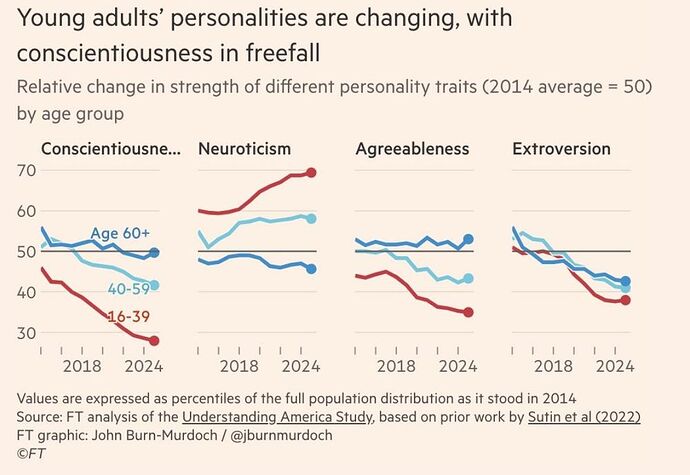Guess, I’m not the only one who thought that.
Here is the link to their website…
None in the ATL thus far…
Very sad news:
I’m wait-listed for the August 23rd event, but no one who was already going is going to cancel this time.
That was quite good, thanks for posting it
https://www.ft.com/content/5cd77ef0-b546-4105-8946-36db3f84dc43
![]() Are they not happy with becoming corporate drones?
Are they not happy with becoming corporate drones?
For what it’s worth, the Big Five is a clinically validated personality metric (unlike, say, just about all the ones that people put on their linkedin profile). That said, the BFI’s definitions for the metrics goes a long way to explaining what might be going on, if you know Thing One about contemporary society and young people’s experience in it.
- Openness to Experience (10 items): This subscale assesses traits like intellectual curiosity, creativity, and a preference for novelty.
- Conscientiousness (9 items): This component evaluates an individual’s tendency to be organized, dependable, and self-disciplined.
- Extraversion (8 items): Indeed, this part measures characteristics such as sociability, assertiveness, and emotional expressiveness.
- Agreeableness (9 items): This section gauges tendencies to be compassionate, cooperative, and trustworthy.
- Neuroticism (8 items): Finally, this subscale assesses the propensity to experience negative emotions like anxiety, anger, and sadness.
I can’t imagine why, say, young adults might have more trouble succeeding on metrics of organization and dependability, or why they might be experiencing more anger, anxiety, and sadness in 2025.
Also, it’s interesting that the report omits openness. I don’t have the patience to dig through the study to see what’s going on with those scores, but I’m ready to conjecture that there are changes to that metric that FT has chosen not to report since it interferes with their narrative.
Incidentally:
The BFI is scored on a 5-point likert scale on 44 items. For “conscientiousness” the items are:
3. Does a thorough job
8. Can be somewhat careless
13. Is a reliable worker
18. Tends to be disorganized
23. Tends to be lazy
28. Perseveres until the task is finished
33. Does things efficiently
38. Makes plans and follows through with them
43. Is easily distracted
… with items 8, 18, 23, and 43 scored “reversed” (so that a score of 1 is tallied as 5, and vice versa).
(NB there are a few different versions of this instrument, all pretty close to each other, but I am not sure if this particular version is authoritative. I used this source.)
In any case, it should be clear how living in a collapsing society as a physically, emotionally, and temporally overtaxed vassal to corporate culture might drag these scores down.
(And to be sure, a glance at the instrument also makes it clear that a person’s responses will not direcly measure their personality but rather how their personality fits into the culture the person is in. So FT’s framing that “young adults are less conscientious to a concerning degree” is naive at best and dishonest at worst: the real story is that “young adults find themselves in a society where the demands of conscientiousness are increasingly impossible to meet.”)
(edit: fix markdown auto-numbering)
And all of that is coming out after isolation in COVID, which seems to have disproportionately affected young people and children, who were developing life and social skills at the time.
Disasters interest me and this is certainly a disaster, written as a thoughtful account of how people managed (or didn’t).
Something something situational awareness something…

From the graphs posted above, it looks like all of those trends were already in action years before the pandemic, which is interesting.
It’s such a short timeline with so few data points (6) though. It would be much more interesting to see a plot going back to say the 1960s (when pretty much all the graphs in Bowling Alone show a marked change), or before.
It would be interesting to see the data from before 2016. Maybe starting at 2008…
Hoover’s adherence to failed republican economic policies cultivated the great depression. He doesn’t get a pass on that despite who is in the White House today.
Yeah, and his vacuum cleaners just sucked.
I think a lot of people crave something real in an increasingly denatured world.
And to really own something tangible that can’t be deleted by our overlords.


